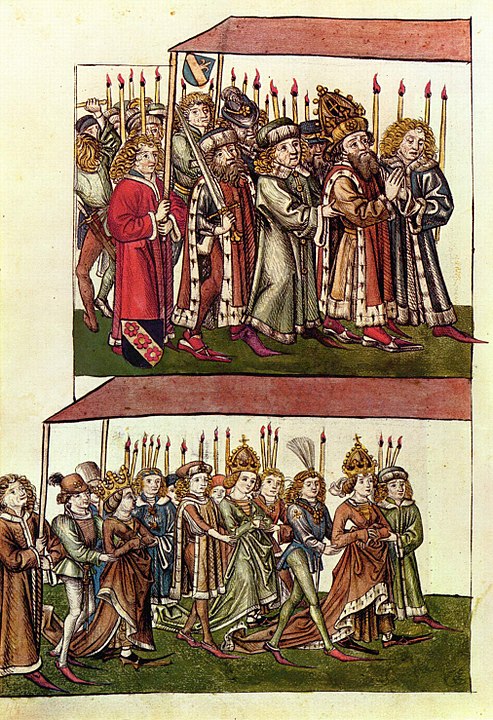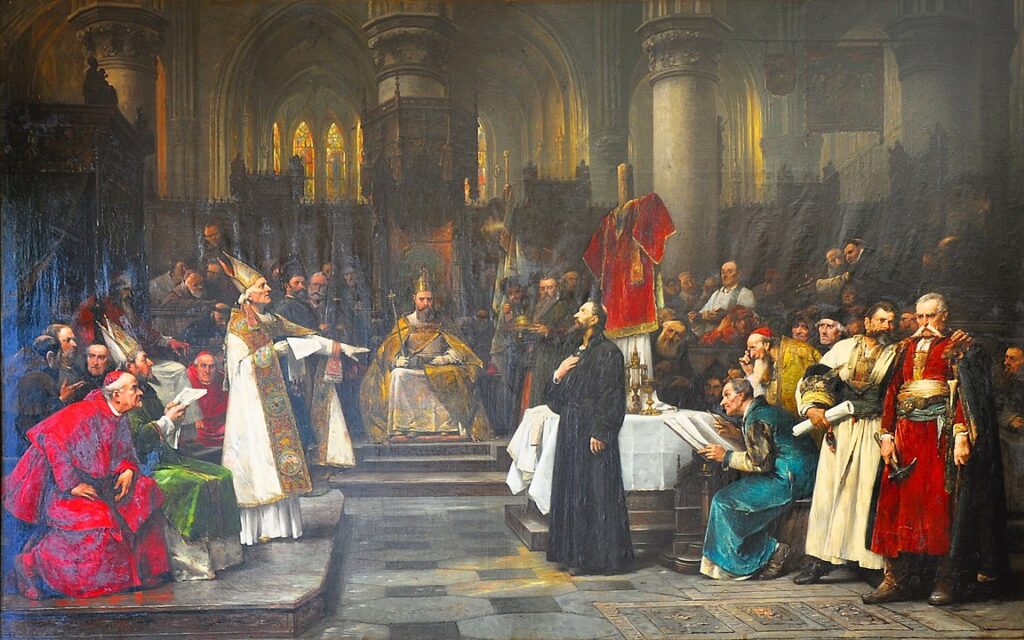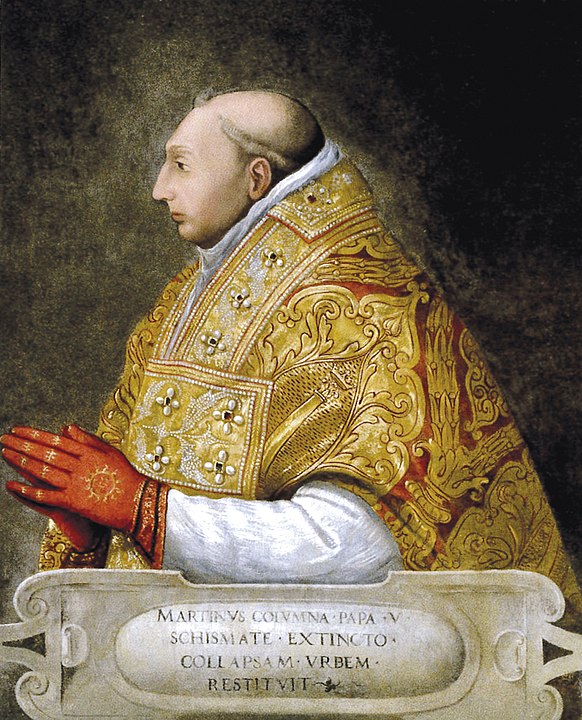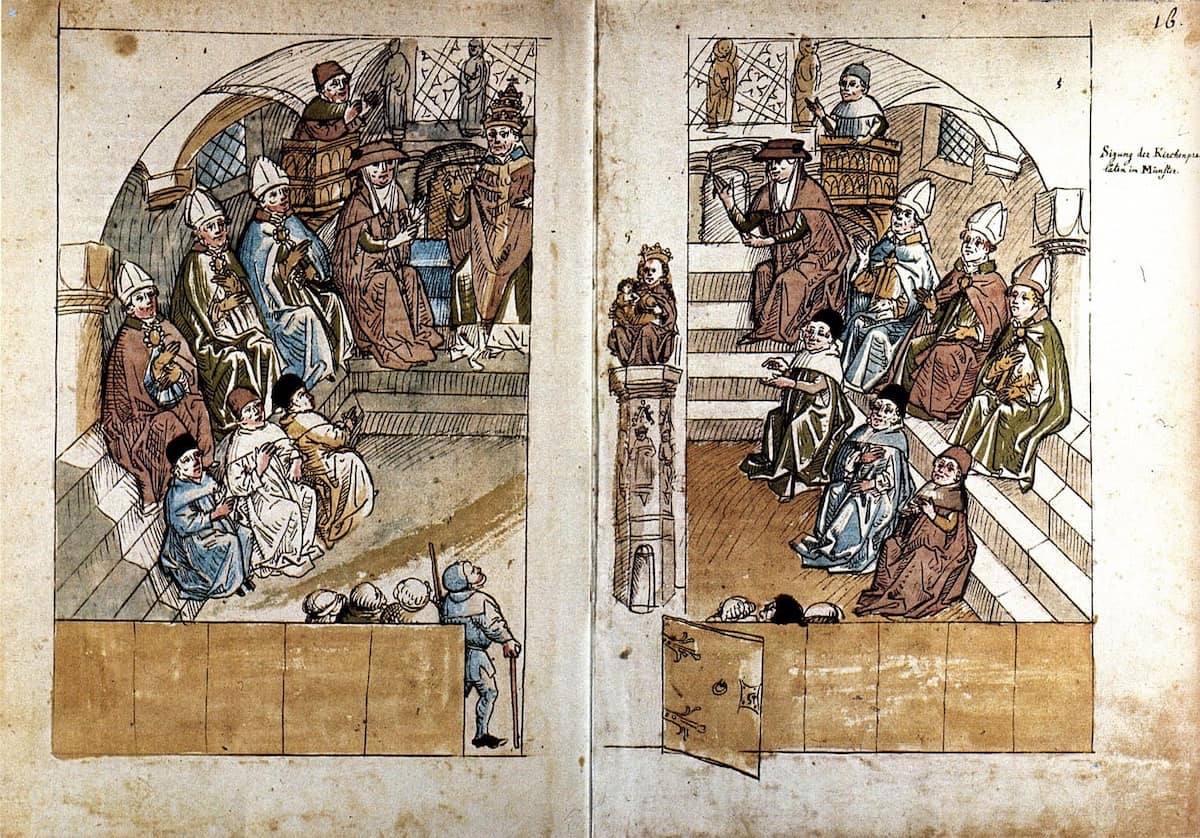The Council of Constance was convened by Pope John XXIII at the request of Sigismund, King of the Romans, in 1414. It lasted until 1418 and was attended by about 600 representatives from various countries and religious orders. The council had three main objectives:
- To end the Western Schism, which had resulted from the election of rival popes in Rome and Avignon since 1378. The council deposed or accepted the resignation of the three claimants (John XXIII, Gregory XII, and Benedict XIII) and elected a new pope, Martin V, in 1417.
- To reform the ecclesiastical government and life, which had been corrupted by abuses and scandals. The council issued several decrees on matters such as the frequency of councils, the election of popes, the rights and duties of bishops, the discipline of clergy, and the administration of justice.
- To repress heresy, especially the teachings of John Wycliffe and Jan Hus, who had challenged the authority and doctrine of the church. The council condemned both as heretics and ordered their writings to be burned. Hus, who had come to the council under a safe-conduct from Sigismund, was arrested, tried, and executed by burning at the stake in 1415.
The Council of Constance was significant for its role in the debates over ecclesial conciliarism and papal supremacy. Conciliarism was the theory that the supreme authority in the church resided in the general councils, not in the popes. The council asserted this principle in two decrees: Haec sancta (1415), which declared that the council derived its power directly from Christ and could judge the pope, and Frequens (1417), which stipulated that councils should be held regularly every ten years.
However, these decrees were controversial and disputed by subsequent popes, who claimed that they were invalid or limited to the specific situation of the schism. The council also failed to achieve a lasting reform of the church, as many of its decrees were ignored or resisted by the papacy and the clergy.
Key Figures at the Council of Constance

- Sigismund, King of the Romans and later Holy Roman Emperor, who initiated and presided over the council. He was the main promoter of the conciliarist movement and the protector of Jan Hus until his arrest.
- Pope John XXIII, one of the three rival popes at the time of the council. He was the one who formally convoked the council, but he later fled from Constance and was deposed by the council.
- Jan Hus, a Czech reformer and follower of John Wycliffe. He came to the council under a safe-conduct from Sigismund, but he was accused of heresy, refused to recant, and was burned at the stake in 1415.
- Pierre d’Ailly, Cardinal and Bishop of Cambrai. He was one of the leaders of the French delegation and a prominent theologian. He advocated for the unity of the church and the reform of the papacy.
- Jean Gerson, Chancellor of the University of Paris and representative of the French king. He was known as “the soul of the council” and a master of eloquence. He defended the authority of the council over the pope and the condemnation of Hus.
- Martin V, the pope elected by the council in 1417. He ended the Western Schism and restored the papal authority, but he also opposed some of the conciliarist decrees and the reform proposals of the council.
Cause of the Reformation
During the sessions, on October 30, 1417, the council identified 18 reform issues, encompassing matters such as the composition of the college of cardinals, the deposition of the pope, and challenges related to simony and finances. Due to internal disagreements, not all proposed reforms were considered. The approved provisions included:
- Revocation of all exemptions granted after 1378.
- Prohibition of the distribution of ecclesiastical benefices to non-consecrated individuals.
- Limitation of clergy reform to ecclesiastical dress.
- Prohibition of distributing the Eucharist to the laity under both species.
- Approval of the periodicity of councils (Decree Frequens).
- Establishment of norms to prevent new schisms.
On April 19, 1418, Martin V called for the next council in Pavia, and on April 22, during the final session, the pope endorsed all decrees, including those predating his election. Subsequently, in 1446, Eugene IV reaffirmed the council and its decrees.
How Did People React to Jan Hus’ Execution?

Outrage and revolt in Bohemia: Hus was a popular preacher and reformer in his homeland of Bohemia, where many people shared his views and criticized the corruption and abuses of the church. His execution was seen as a grave injustice and a violation of the safe conduct granted by Sigismund.
Many Bohemians rose up in armed rebellion against the church and the emperor, starting the Hussite Wars that lasted for more than a decade. The Hussites formed their own church and defended their religious and national rights against several crusades launched by the pope and the emperor.
Support and sympathy from other reformers: Hus was not alone in his critique of the church and his desire for reform. He was influenced by the writings of John Wycliffe, an English theologian who had also been condemned as a heretic by the council.
Many other reformers, such as Martin Luther, John Calvin, and John Knox, later recognized Hus as a precursor and a martyr of the Protestant Reformation. They praised his courage and his fidelity to the Scriptures and denounced his execution as a crime and a scandal.
Indifference and hostility from the church and the emperor: The council and the pope did not show any remorse or regret for the execution of Hus. They considered him a dangerous and obstinate heretic who deserved the punishment. They also issued a decree that forbade anyone from questioning or appealing the council’s decisions and threatened anyone who supported Hus or his followers with excommunication and anathema.
Sigismund, who had hoped to use the council to restore his authority and prestige, also failed to intervene or protect Hus. He was more concerned with his political ambitions and his reputation as a defender of the faith than with the rights and fate of Hus.
What Were Some of the Main Beliefs of Jan Hus?
The supreme authority of the Scriptures over the pope and the church tradition: Hus believed that the Bible was the word of God and the only infallible rule of faith and practice. He rejected any doctrines or practices that contradicted the Scriptures, such as indulgences, papal infallibility, and clerical celibacy.
The priesthood of all believers and the right of the laity to receive both the bread and the wine in communion: Hus argued that every Christian had direct access to God through Christ and that the clergy had no special privileges or powers. He also advocated for the restoration of the cup (calix) to the laity, which had been denied by the church since the 13th century.
The necessity of personal repentance and faith for salvation: Hus emphasized the importance of inward piety and moral purity rather than outward rituals and ceremonies. He taught that salvation was a gift of God’s grace, not a result of human works or merits. He also denounced the abuse of indulgences, which were sold by the church as a way of reducing the temporal punishment for sins.
What Was the Role of Women at the Council of Constance
The role of women at the Council of Constance in 1414 was not very prominent, as the council was dominated by male clergy and secular rulers. However, there were some exceptions and examples of women’s involvement and influence in the council. Here are some of them:
Barbara of Celje, the second wife of Emperor Sigismund, initiated and presided over the council. She accompanied her husband to Constance and played a diplomatic role in the negotiations and relations with the different parties and factions. She also supported the election of Martin V as the new pope and received his blessing.
Jan Hus’ female followers, who defended his teachings and protested his execution, Some of them wrote letters to the council, denouncing the injustice and cruelty of his trial and death. Others joined the Hussite movement and fought in the Hussite Wars, which broke out after Hus’ martyrdom. Hus himself had a positive view of women and allowed them to preach and serve in battle.
The voting members of the laity were allowed to participate in the council’s deliberations and decisions. Among them were some women, such as the representatives of the cities of Basel, Strasbourg, and Constance. They had a voice and a vote in the council, and they were effective in promoting the conciliarist agenda and the reform of the church.
What Was the Role of the Pope at the Council?

The role of the pope at the Council of Constance in 1414 was controversial. There were three rival popes at the time of the council: John XXIII, Gregory XII, and Benedict XIII. The council aimed to end the schism by deposing or accepting the resignation of all three and electing a new pope. However, each pope had different attitudes towards the council.
John XXIII was the one who formally convoked the council, but he later fled from Constance and was deposed by the council. He initially agreed to resign if the other two popes did the same, but he changed his mind when he realized that the council was not favorable to him. He also opposed the conciliarist decrees that asserted the authority of the council over the pope.
Gregory XII was the only pope who voluntarily resigned and recognized the council as legitimate. He sent his representatives to the council and authorized them to renounce his claim to the papacy. He also agreed to the conciliarist decrees and supported the election of Martin V as the new pope.
Benedict XIII was the most stubborn and defiant of the three popes. He refused to resign or acknowledge the council as valid. He also tried to undermine the council by calling his own council in Perpignan and by excommunicating the council members. He was eventually deposed by the council and by his own cardinals, but he never accepted his deposition and continued to claim the papacy until his death.




